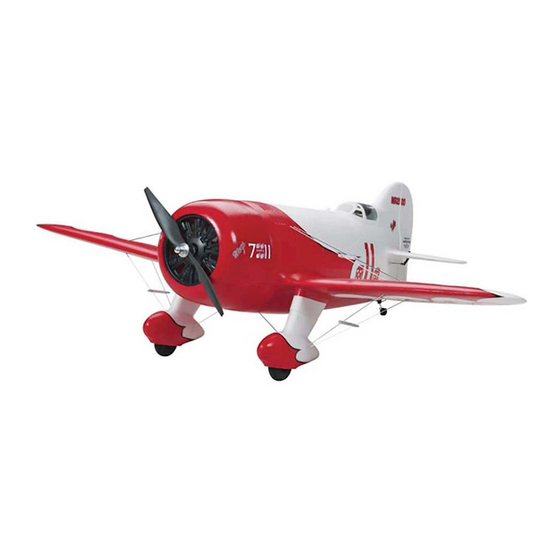GREAT PLANES Gee Bee Gebrauchsanweisung - Seite 12
Blättern Sie online oder laden Sie pdf Gebrauchsanweisung für Spielzeug GREAT PLANES Gee Bee herunter. GREAT PLANES Gee Bee 16 Seiten. Model aircraft great planes gee bee

PREFLIGHT
Identify Your Model
No matter if you fl y at an AMA sanctioned R/C club site or if
you fl y somewhere on your own, you should always have your
name, address, telephone number and AMA number on or
inside your model. It is required at all AMA R/C club fl ying sites
and AMA sanctioned fl ying events. Fill out the identifi cation
tag on page 15 and place it on or inside your model.
Charge the Batteries
Follow the battery charging instructions that came with your
radio control system to charge the batteries. You should always
charge your transmitter batteries the night before you go fl ying,
and at other times as recommended by the radio manufacturer.
CAUTION: Unless the instructions that came with your
radio system state differently, the initial charge on new
transmitter should be done for 15 hours using the slow-
charger that came with the radio system. This will
"condition" the batteries so that the next charge may be done
using the fast-charger of your choice. If the initial charge is
done with a fast-charger the batteries may not reach their
full capacity and you may be fl ying with batteries that are
only partially charged.
Balance Propellers
Carefully balance your propeller and spare propellers before
you fl y. An unbalanced prop can be the single most signifi cant
cause of vibration that can damage your model. Not only
will motor mounting screws and bolts loosen, possibly with
disastrous effect, but vibration may also damage your radio
receiver and battery.
We use a Top Flite Precision Magnetic Prop Balancer
(TOPQ5700) in the workshop and keep a Great Planes
Fingertip Prop Balancer (GPMQ5000) in our fl ight box.
Ground Check and Range Check
Always ground check the operational range of your radio
before the fi rst fl ight of the day following the manufacturer's
instructions that came with your radio. This should be done
once with the motor off and once with the motor running at
various speeds. If the control surfaces do not respond correctly,
do not fl y! Find and correct the problem fi rst. Look for loose
servo connections or broken wires, corroded wires on old
servo connectors, poor solder joints in your battery pack or a
defective cell, or a damaged receiver crystal from a previous
crash. Make sure the receiver antennas are positioned as
recommended in the radio instructions.
MOTOR & BATTERY SAFETY PRECAUTIONS
Failure to follow these safety precautions may result
in severe injury to yourself and others.
Do not run the motor in an area of loose gravel or sand; the
propeller may throw such material in your face or eyes.
Keep your face and body as well as all spectators away from
the plane of rotation of the propeller while the motor is running.
Keep these items away from the prop: loose clothing, shirt
sleeves, ties, scarfs, long hair or loose objects such as pencils
or screwdrivers that may fall out of shirt or jacket pockets into
the prop.
The motor gets hot! Do not touch it right after operation.
Once the motor battery is connected to the ESC, stay clear
of the propeller. The motor could start at any time.
LITHIUM BATTERY HANDLING & USAGE
WARNING: Read the entire instruction sheet included with
your battery. Failure to follow all instructions could cause
permanent damage to the battery and its surroundings and
cause bodily harm!
ONLY use a LiPo approved charger. NEVER use a
NiCd/NiMH peak charger to charge a LiPo battery.
NEVER charge in excess of 4.20V per cell.
ONLY charge through the "charge" lead. NEVER
charge through the "discharge" lead.
NEVER charge at currents greater than 1C unless
the battery is rated for a higher charge rate.
ALWAYS set the charger's output volts to match the
battery volts.
ALWAYS charge in a fi reproof location.
NEVER trickle charge.
NEVER allow the battery temperature to exceed 150
degrees F (65 degrees C).
12
